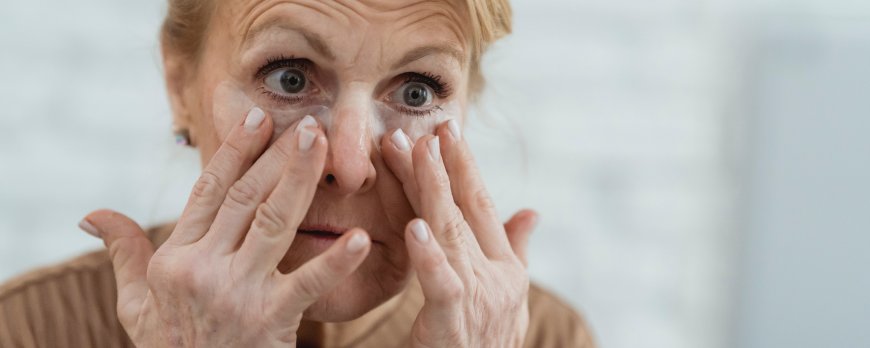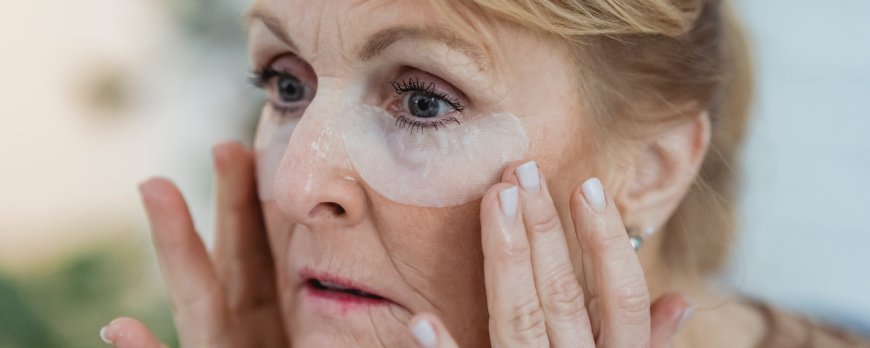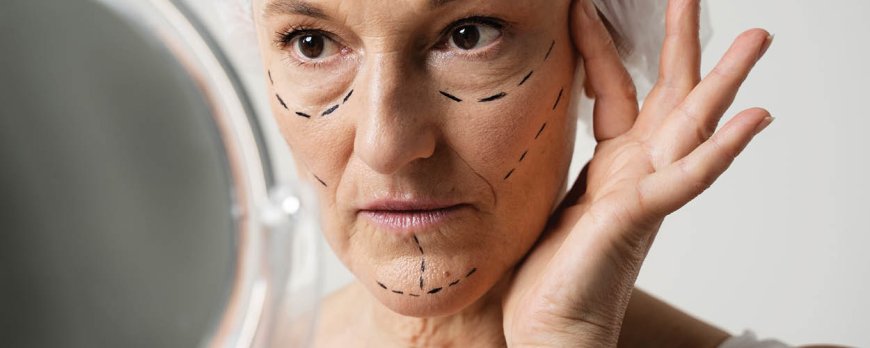What makes a face look old?
Uncover the mysteries of aging with 'What makes a face look old?'. Explore key factors contributing to facial aging and gain insights on combating it.

What makes a face look old?
Facial aging is a natural process that involves various factors leading to changes in the appearance of the face. Several factors can contribute to making a face look old. Heavy eyelids occur due to the loss of collagen and elastin and stretching of muscles over time. Age spots, or brown splotchy sunspots, are caused by DNA and sun damage. Thinning brows can be caused by genetics, aggressive tweezing, and nutritional deficiencies. Crepey skin is a result of sun damage, which causes dry, loose, and papery skin texture. An uneven complexion is due to loss of collagen and elastin, slower turnover of dead skin cells, less oil production, and acne scarring. Dark circles may appear due to loss of fat volume in the lower eyelid area and thinning skin. A double chin can be caused by genetics, the accumulation of fat under the chin, and sagging neck muscles. A hollowed face is the result of ligament loosening and the dropping of fatty tissue in the cheekbones. Other factors that contribute to an aging appearance include lack of sleep, sipping drinks through a straw, stress, relying on makeup alone for sunscreen protection, neglecting the neck and hands from sun exposure, forgetting to wear sunglasses, and using drying soap.
Key Takeaways:
- Heavy eyelids, age spots, thinning brows, crepey skin, uneven complexion, dark circles, double chin, and a hollowed face all contribute to an aged appearance.
- The loss of collagen and elastin, sun damage, genetics, and lifestyle habits are some factors that age the face.
- Avoiding excessive sun exposure, adopting a healthy skincare routine, and addressing lifestyle habits can help delay the signs of facial aging.
- Proper eye care, protection from the sun, and maintaining a healthy lifestyle can contribute to a more youthful-looking face.
- Consulting with a dermatologist or skincare specialist can provide personalized advice and treatments to address specific aging concerns.

Loss of Collagen and Elastin
The loss of collagen and elastin in the skin is a major factor in the aging of facial features. These proteins are responsible for maintaining the firmness, elasticity, and structure of the skin. As we age, the production of collagen and elastin naturally declines, leading to a reduction in skin thickness and elasticity.
With the loss of collagen and elastin, facial skin becomes thinner and more prone to sagging. This can result in the formation of wrinkles, fine lines, and loose skin. Additionally, the loss of support from these proteins can contribute to the appearance of hollowed cheeks, sunken eyes, and drooping eyebrows.
To combat the effects of collagen and elastin loss, there are various treatments available, such as dermal fillers and skin tightening procedures. These interventions can help restore volume and tightness to the skin, reducing the signs of facial aging.
- Wrinkles and fine lines
- Sagging skin
- Hollowed cheeks and sunken eyes
Prevention Tips:
- Protect the skin from sun damage by applying sunscreen daily and wearing protective clothing and accessories.
- Adopt a skincare routine that includes moisturizers and products containing ingredients that stimulate collagen and elastin production.
- Eat a balanced diet rich in nutrients that support skin health, such as vitamin C, antioxidants, and omega-3 fatty acids.
- Avoid smoking and limit alcohol consumption, as these habits can accelerate collagen and elastin breakdown.
Sun Damage and Age Spots
Sun damage, including the formation of age spots, can significantly age the skin and impact the overall appearance of the face. Age spots, also known as brown splotchy sunspots, are caused by a combination of DNA damage and prolonged exposure to the sun's harmful UV rays. Over time, these spots can darken and become more prominent, leading to an aged and uneven complexion.
In addition to age spots, sun damage can also contribute to other age-related facial changes. The sun's UV rays can break down collagen and elastin in the skin, leading to a loss of elasticity and firmness. This can result in the development of fine lines, wrinkles, and sagging skin. The skin may also become dry, rough, and textured, with a crepey appearance.
To protect your skin from sun damage and minimize the formation of age spots, it is essential to practice good sun protection habits. This includes wearing sunscreen with a high SPF on a daily basis, seeking shade during peak sun hours, and wearing protective clothing, such as hats and sunglasses. Regularly examining your skin for any changes or new spots is also important in detecting potential skin damage early on.
In summary, sun damage and the formation of age spots can significantly contribute to an aged facial appearance. By taking precautions to protect your skin from the sun's harmful rays, you can help maintain a more youthful and vibrant complexion.
Thinning Brows: A Sign of Facial Aging
Thinning brows can be an indicator of facial aging and are influenced by various factors. As we age, our eyebrow hair tends to become sparser and lighter in color. This loss of thickness and density can significantly impact the overall appearance and symmetry of the face.
One of the primary causes of thinning brows is genetics. Some individuals are simply predisposed to having thinner eyebrows as they age. Additionally, aggressive tweezing and over-plucking can lead to permanent hair loss and thinning over time. Nutritional deficiencies, such as deficiencies in vitamins A, C, and E, can also contribute to eyebrow thinning.
Fortunately, there are ways to address thinning brows and restore a more youthful appearance. Eyebrow pencils, powders, and gels can be used to fill in sparse areas and create a fuller look. Microblading, a semi-permanent makeup technique, can also be a suitable option for those looking for a longer-lasting solution. Additionally, incorporating a balanced diet rich in essential nutrients can help promote healthier hair growth.
Factors that Contribute to Thinning Brows:
- Genetics
- Aggressive tweezing and over-plucking
- Nutritional deficiencies, particularly vitamins A, C, and E
While thinning brows may be an inevitable part of the aging process for many people, understanding the underlying factors can help in making informed decisions about addressing this common sign of facial aging. By incorporating appropriate remedies and techniques, it is possible to restore fullness and regain a more youthful brow appearance.

Crepey Skin: A Common Sign of an Aging Face
Crepey skin, characterized by its dry and papery texture, is a common sign of an aging face. It occurs due to the loss of collagen and elastin, which are essential proteins responsible for maintaining the skin's firmness and elasticity. As we age, our bodies produce less collagen and elastin, leading to the thinning and weakening of the skin.
In addition to collagen and elastin loss, other factors contribute to the development of crepey skin. Sun damage plays a significant role, causing dryness and a breakdown of the skin's natural moisture barrier. This, combined with the natural aging process, can result in the skin becoming dehydrated and lacking the plumpness and smoothness of youth.
The Causes of Crepey Skin Include:
- Excessive sun exposure: UV rays from the sun damage the skin's collagen and elastin, leading to the development of crepey skin.
- Poor skincare routine: Neglecting to moisturize regularly and protect the skin from environmental aggressors can contribute to the appearance of crepiness.
- Smoking: Cigarette smoke contains harmful chemicals that accelerate the aging process and contribute to the breakdown of collagen and elastin fibers.
- Poor nutrition: A diet lacking in essential nutrients can impact the skin's health and contribute to the development of crepey skin.
While crepey skin is a natural part of the aging process, there are ways to minimize its appearance and maintain a more youthful complexion. Proper skincare, including regular moisturization and the use of products that promote collagen production, can help improve the skin's elasticity and reduce the visible signs of crepiness.
Uneven Complexion
An uneven complexion can be a result of various factors and is often associated with an aged appearance. The loss of collagen and elastin in the skin, along with slower turnover of dead skin cells, can lead to a dull and uneven texture. Additionally, factors such as less oil production and the presence of acne scarring can contribute to an uneven complexion.
One of the primary causes of an uneven complexion is the loss of collagen and elastin. These proteins provide structural support to the skin and help maintain its elasticity. As we age, collagen and elastin levels naturally decline, leading to a loss of firmness and the development of uneven texture. The slower turnover of dead skin cells also plays a role, as it can lead to a buildup of dull, rough skin.
Another factor that contributes to an uneven complexion is the production of less oil by the skin. Oil helps to keep the skin moisturized and smooth, and a decrease in oil production can result in dryness and an uneven surface. Additionally, acne scarring can leave behind marks and discoloration that contribute to an uneven appearance.
To address an uneven complexion, it's important to focus on a skincare routine that promotes cell turnover and nourishes the skin. This can include exfoliating regularly to remove dead skin cells, using products that contain ingredients like retinol to stimulate collagen production, and moisturizing to improve hydration levels. It's also essential to protect the skin from further damage by wearing sunscreen daily and avoiding excessive sun exposure.
Key Points:
- The loss of collagen and elastin, along with slower turnover of dead skin cells, can lead to an uneven complexion.
- Less oil production and the presence of acne scarring can also contribute to an uneven appearance.
- To address an uneven complexion, focus on a skincare routine that promotes cell turnover and nourishes the skin.
- Regular exfoliation, use of collagen-stimulating ingredients, moisturization, and sun protection are key for improving an uneven complexion.
Dark Circles
Dark circles under the eyes can be a visible sign of facial aging and are influenced by multiple factors. These include the loss of fat volume in the lower eyelid area and thinning of the delicate skin that surrounds the eyes. As we age, the skin becomes thinner and more transparent, making blood vessels beneath the surface more noticeable. This can result in the appearance of dark circles.
In addition to aging, other factors such as genetics and lifestyle choices can contribute to the development of dark circles. Hereditary factors can cause certain individuals to have naturally darker skin under their eyes, making dark circles more prominent. Lack of sleep and fatigue can also exacerbate the appearance of dark circles, as they can cause the blood vessels to dilate and become more visible.
To minimize the appearance of dark circles, there are several remedies that can be beneficial. Using a good quality under-eye cream or serum that contains ingredients such as vitamin C, retinol, and hyaluronic acid can help to brighten the under-eye area and reduce the appearance of dark circles. Applying cold compresses, such as chilled cucumber slices or tea bags, can also temporarily constrict blood vessels and reduce puffiness.
Factors that contribute to the development of dark circles include:
- Loss of fat volume in the lower eyelid area
- Thinning of the delicate skin surrounding the eyes
- Genetic predisposition to darker skin under the eyes
- Lack of sleep and fatigue
It is important to note that while these remedies can provide temporary relief, addressing lifestyle factors such as getting adequate sleep, managing stress, and maintaining a healthy diet can also help to prevent or minimize the appearance of dark circles in the long term.
Double Chin
A double chin can significantly impact the perceived age of the face and is influenced by a variety of factors. Genetics play a role in the development of a double chin, as some individuals may be more predisposed to storing excess fat under their chin. Additionally, the accumulation of fat in the submental area can contribute to the appearance of a double chin, especially as we age and our metabolism slows down.
Another factor that can contribute to a double chin is the weakening and sagging of neck muscles. As the muscles lose their tone and elasticity over time, they are less able to support the overlying skin and fat, resulting in a drooping appearance. Poor posture can also contribute to the development of a double chin, as it puts extra strain on the neck muscles and can lead to muscle weakness and laxity.
To address a double chin, there are several treatment options available. Non-surgical approaches such as Kybella, a FDA-approved injectable, can be used to reduce fat under the chin. This medication works by destroying fat cells, gradually reducing the fullness in the area. In some cases, liposuction may be recommended to remove excess fat from the submental area. Surgical procedures like neck lift or facelift can also be considered to tighten the neck muscles and remove excess skin.
Factors that contribute to facial aging:
- Loss of collagen and elastin
- Sun damage and age spots
- Thinning brows
- Crepey skin
- Uneven complexion
- Dark circles
- Double chin
- Other factors
Other factors that contribute to an aging appearance of the face include lack of sleep, sipping drinks through a straw, stress, relying on makeup alone for sunscreen protection, neglecting the neck and hands from sun exposure, forgetting to wear sunglasses, and using drying soap. It is important to keep in mind that while these factors can contribute to an aged appearance, there are various treatments and lifestyle changes that can help slow down the aging process and maintain a youthful look.
In addition to the specific factors discussed earlier, there are several other common factors that can contribute to an aged facial appearance. Understanding these factors can help individuals make informed choices when it comes to skincare and lifestyle habits.
Sleep deprivation can have a significant impact on the appearance of the face. It can lead to dark circles under the eyes, dull complexion, and the formation of fine lines and wrinkles. Getting an adequate amount of quality sleep is essential for maintaining a youthful and vibrant appearance.
While sun damage was briefly mentioned earlier, it is worth emphasizing the importance of protecting the skin from harmful ultraviolet (UV) rays. Neglecting to wear sunscreen or protective clothing can lead to premature aging, including wrinkles, age spots, and uneven skin texture. It is crucial to wear a broad-spectrum sunscreen daily and seek shade during peak sun hours.
By being aware of these common factors, individuals can take proactive measures to minimize their impact on the aging process and maintain a more youthful appearance.
Other Factors Contributing to Facial Aging
Lack of Sleep
Unprotected Sun Exposure
Poor Lifestyle Choices
Conclusion
Understanding the factors that contribute to making a face look old is crucial for developing effective strategies to combat and minimize the visible signs of aging.
Several factors can contribute to an aged facial appearance. Heavy eyelids, caused by the loss of collagen and elastin and stretching of muscles over time, can give the eyes a tired and droopy appearance. Age spots, also known as brown splotchy sunspots, are the result of DNA and sun damage, further adding to the aged look.
Thinning brows can be influenced by genetics, aggressive tweezing, and nutritional deficiencies, which can alter the overall balance and harmony of facial features. Sun damage can also lead to crepey skin, characterized by dry, loose, and papery texture, adding to the signs of aging.
An uneven complexion can result from the loss of collagen and elastin, slower turnover of dead skin cells, less oil production, and acne scarring. Dark circles may appear due to the loss of fat volume in the lower eyelid area and thinning skin, making the face appear tired and worn out.
A double chin can be caused by genetics, the accumulation of fat under the chin, and the sagging of neck muscles. Additionally, a hollowed face can result from ligament loosening and the dropping of fatty tissue in the cheekbones.
It is important to note that there are other factors that contribute to an aging appearance as well. Lack of sleep, sipping drinks through a straw, stress, relying solely on makeup for sunscreen protection, neglecting the neck and hands from sun exposure, forgetting to wear sunglasses, and using drying soap can all contribute to an aged facial appearance.
By understanding these factors, individuals can take proactive steps to minimize the visible signs of aging and develop personalized strategies to maintain a youthful appearance.


































































































































